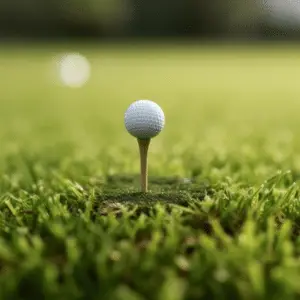Last Updated on June 12, 2023
Golf is a popular sport around the world, bringing joy to many avid players. But have you ever wondered who invented the first golf tee? It’s not something that people think about often, but its impact on the game has been profound. In this article, we will delve into the fascinating story of how it all began and discover who was responsible for inventing the very first golf tee.
Invention of the First Tees
The invention of the golf tee is credited to Scotsman Dr. George Grant and his associate, William Bloxsom, who patented the first wooden tee in 1899. The pair had observed that playing with a raised ball off the ground improved accuracy and distance.
| Features | Benefits |
|---|---|
| Raised Ball | Improved Accuracy & Distance |
| Wooden Tee | Easy to Manufacture & Use |
| Scottish Origins | Popularised Worldwide |
Grant’s design was revolutionary as it allowed players to play without having to dig their own holes or drive stakes into the ground. It also encouraged more people to take up the game of golf as its simplicity made it easier for beginners. Furthermore, its affordability meant that courses could be opened at lower costs than what was previously possible when using other methods such as sandtraps and wicker baskets filled with salt hay. This led to an explosion in the popularity of the sport worldwide.
Today, modern tees are constructed from a variety of materials, including wood, plastic, rubber, metal and even bamboo! They come in several different sizes depending on conditions and golfer preference. As well as being used by recreational players all over the world, professional tournaments make use of them too – making this simple invention one of the oldest pieces of equipment still widely used today.
Early Teeing Grounds
Early teeing grounds were often located near rivers or seaside areas, and they served as gathering places for those passionate about golfing origins. People would come together to practice their swings by hitting pebbles off mounds of sand into holes carved out from nearby rocks. The earliest evidence of such activity dates back to 14th-century Scotland; however, similar practices had perhaps already existed centuries prior in other parts of the British Isles.
Today, these ancient teeing sites are still some of the most popular destinations for keen golfers:
- St Andrews Links in Fife, Scotland, is known as one of the oldest continuously used teeing grounds in existence
- Machrihanish Golf Club in Argyll & Bute, Scotland, was founded in 1779 and offers stunning coastal views while playing 18 holes along its lush greens
- Royal Blackheath Golf Club in London has been providing challenging rounds since 1608
- North Berwick West Links course lies just east of Edinburgh and was frequented by Mary Queen of Scots herself
- Musselburgh Old Course on East Lothian’s coast holds records for being among the oldest purpose-built tracks ever constructed
These iconic locations all provide an insight into golf’s past – inviting visitors to tread where so many others have gone before them!
Development of Modern Tees

The invention of the modern golf tee is credited to George Grant in 1899. He patented a wooden peg which was used for driving off and kept the ball from rolling away on a sloping surface. This original design had been improved over time, with rubber tees becoming available during World War I.
Plastic tees emerged in the 1950s as an alternative to rubber or wooden ones. These were lightweight and flexible, making them ideal for amateurs and professionals alike. Disposable plastic tees became popular, too, offering convenience at a lower cost than their more durable counterparts. The development of these disposable tees has helped shape modern golfing practices by allowing players to quickly replace worn-out equipment without having to purchase new replacements. All in all, modern golfers have benefited greatly from advances made in tee technology over the past century.
Frequently Asked Questions
What Is the Best Type of Golf Tee to Use?
When it comes to golf tees, there are a variety of options available. The best type of golf tee to use will depend on the golfer’s preferences and needs. Plastic tees, rubber tees, and wooden tees all have their own advantages:
- Plastic tees hold the ball securely while offering increased distance compared to other types of tees;
- Rubber tees provide more flexibility and stability than plastic or wooden alternatives;
- Wooden tees offer superior durability but can be difficult to insert into the ground;
- They also produce less friction, making them ideal for softer and slower-hitting clubs.
No matter what type is chosen, using a tee correctly can make all the difference in one’s game – from improving accuracy to increasing distance off the tee box. When selecting a golf tee, consider factors such as price point, environmental impact, convenience, and personal preference when making your choice. For example, if you’re looking for something that’s easy to carry around with you during rounds, then plastic or rubber may be better suited as they are lightweight and come in packs of multiple sizes at an affordable cost. On the other hand, if you want something that will last longer, then wooden could be the right option due to its greater strength and longevity, even though it requires extra effort to insert into the ground properly each time before taking a shot.
How Much Does a Golf Tee Cost?
Generally speaking, the cost of a golf tee varies depending on its quality and manufacturer. The average golf tee pricing begins at $0.10 per unit and can reach up to several dollars for more specialised models.
For instance, plastic tees tend to be cheaper than wooden ones, while higher-end tees made from titanium or other metals are usually more expensive. Furthermore, multi-pack deals may offer an overall better value for money in comparison to single purchases. All in all, it’s worth researching which type of golf tee best suits your needs and comparing different prices before making a purchase decision.
Conclusion
In conclusion, golf is a game that has been around for centuries. It has changed and evolved over the years, and there have been many great inventions to help improve our games. One of these inventions was the golf tee which allows us to place the ball on an elevated position so we can hit it with more power and accuracy. We owe this invention to Dr. George Grant, who first came up with the idea in 1899. Although today there are various types of tees available, from plastic or foam to even rubber ones, it would only be possible with the original design created by Dr. George Grant all those years ago. So next time you’re out on the course, remember where it all began – with one man’s vision and determination!



